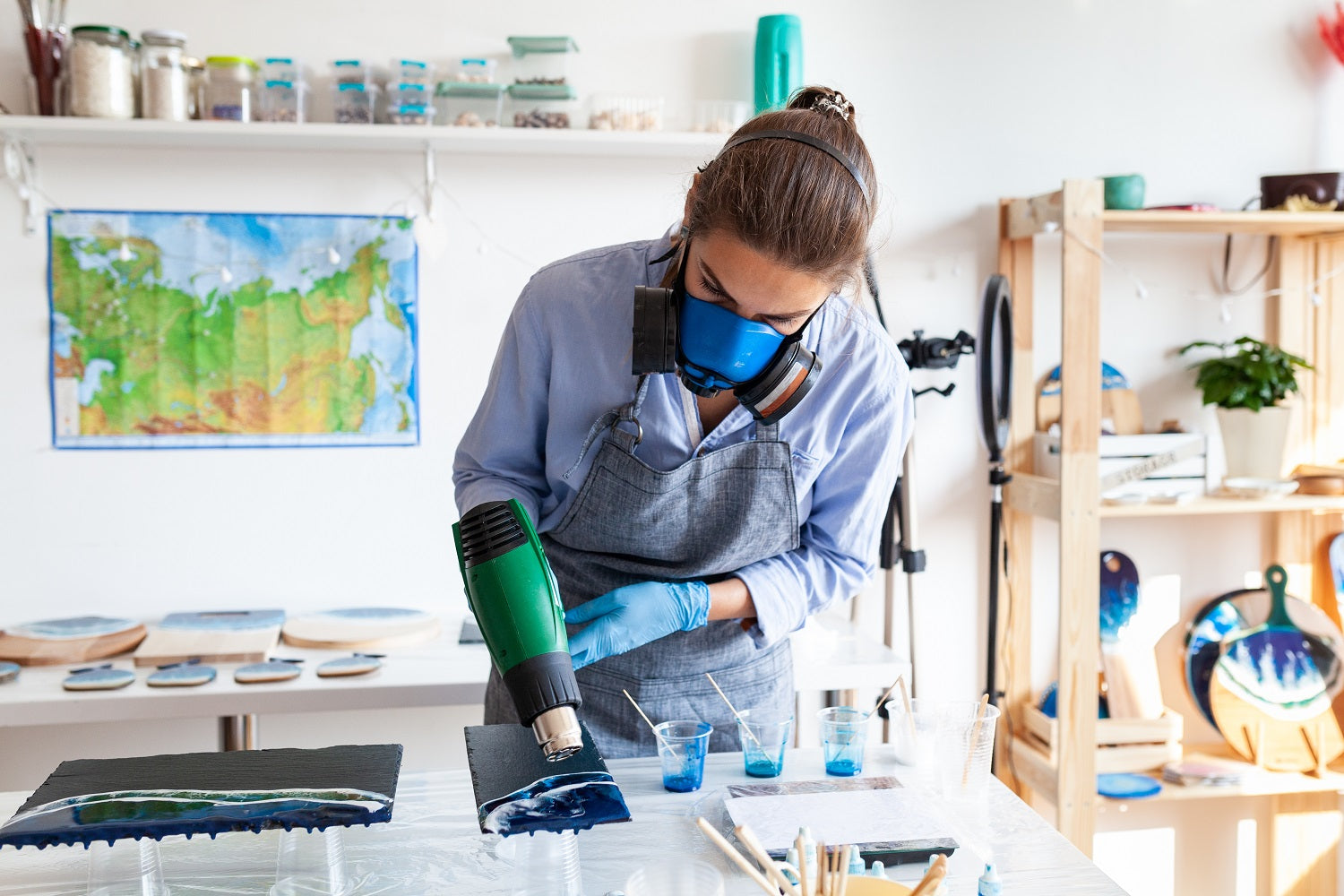Your Cart is Empty
Offering ShopPay at Checkout. Buy Now, Pay Later!
Offering ShopPay at Checkout. Buy Now, Pay Later!

Epoxy Resin Safety 101: Handling, Ventilation, and Best Practices
April 08, 2025 4 min read
Epoxy Resin Safety 101: Handling, Ventilation, and Best Practices
Epoxy resin is a versatile material used for stunning art pieces, durable countertops, flooring, and more. Whileit’s a favorite among craft professionals and resin artists, it requires careful handling to ensure safety.
This guide walks you through essential epoxy resin safety practices. From understanding potential risks to setting up a safe workspace,you’ll learn everything you need to work confidently and responsibly with resin. Whetheryou’re a seasoned professional or a first-time user, these tips will help you create while staying safe.
Understanding the Risks of Epoxy Resin
Every material comes with its own set of risks, and epoxy resin is no exception. Althoughit’s a fantastic medium for creative projects, it can pose health hazards if not handled properly.Here’s what you need to know:
1. Chemical Exposure
Epoxy resin consists of two main components: resin and hardener. When mixed, they undergo a chemical reaction that releases fumescontaining volatile organic compounds (VOCs). Prolonged exposure to these fumes can cause dizziness and headaches.
2. Skin Irritation
Skin contact with uncured resin or hardener is a common issue for beginners. The chemicals can cause allergic reactions, resulting in redness, itching, or even chemical burns.
3. Respiratory Issues
Without proper ventilation, inhaling epoxy fumes can irritate your respiratory system.
Knowing these risks highlights why safety is paramount when working with epoxy resin.
Essential Safety Gear for Working with Epoxy Resin
Protective gear is your first line of defense when handling epoxy resin.Here’s a checklist of must-have safety equipment:
1. Gloves
Nitrile gloves are ideal for protecting your skin from resin and hardener. Be sure to use gloves that provide adequate chemical resistance.
2. Respirators
Use a respirator mask with an organic vapor cartridge to prevent inhaling hazardous fumes. A dust maskwon’t cut it when working with VOCs.
3. Eye Protection
Wear safety goggles to shield your eyes from accidental splashes or spills. Resin can cause severe irritation if itcomes into contact with your eyes.
4. Apron or Long-Sleeve Clothing
Protect your clothing and skin with a disposable apron and long sleeves to reduce skin exposure.
Investing in quality safety gear is non-negotiable;it’s an upfront cost that safeguards your health.
Workspace Ventilation: Setting Up a Safe Environment
Proper ventilation is critical when working with epoxy resin.Here’s how to set up a well-ventilated workspace:
Work in a Room with Cross-Ventilation
Keep windows open and use fans tomaintain fresh air circulation. Be mindful not to stir up too much dust with fans.
Avoid Enclosed Spaces
Never mix or cure epoxy resin in confined spaces. Poor airflow can trap toxic fumes, increasing your exposure.
Remember, good airflow not only protects your respiratory system but also minimizes odor.
Safe Handling Practices for Epoxy Resin
When it comes to epoxy resin, the right techniques make the difference between safe handling and unnecessary risks:
Read the Labels and Safety Data Sheets (SDS):Always review product labels and SDS information provided by the manufacturer.
Measure Accurately:Using the correct ratio of resin to hardener ensures proper curing and reduces the likelihood of releasing excess fumes.
Mix Gently: Stir your resin gently to avoid creating bubbles or splashes.
Avoid Eating or Drinking:Keep food and beverages away from your workspace.
Clean Spills Immediately:Use disposable towels and avoid using bare hands.
Allow Proper Curing Time: Ensure your projecthas fully cured before handling it without gloves.
Proper Disposal Methods for Resin Waste
Disposing of resin waste incorrectly can harm the environment. Follow these guidelines to ensure eco-friendly disposal:
Dispose of Cured Resin as Regular Trash: Once fully cured, resin is inert and can be discarded in your regular trash.
Handle Liquid Waste Carefully: Uncured resin should be taken to a hazardous waste disposal facility.
Reuse When Possible:Save leftover resin for small projects or test pieces to reduce waste.
A little effort in disposal goes a long way in protecting the environment!
First Aid: What to Do in Case of an Accident
Accidents happen, but knowing how to respond can make all the difference. Here are common scenarios and actions you should take:
Skin Contact: Wash the affected areaimmediately with soap and water. Avoid using alcohol or solvents.
Eye Contact:Rinse your eyes with plenty of water for at least 15 minutes and seek medical attentionimmediately.
Fume Overexposure: Move to fresh air if you experience dizziness, headaches, or breathing difficulties.
Always keep the SDS for your epoxy resin product on hand for specific first-aid instructions.
Best Practices for Working with Epoxy Resin
Adopting these best practices can further minimize risks and enhance your experience with epoxy resin:
Plan Ahead: Prepare your workspace and materials before you start mixing resin.
Work in Small Batches:Mix only as much resin as you need to minimize waste and prevent premature curing.
Practice Climate Control:Resin cures best in stable room temperatures (usually between 70-80°F).
Stay Organized:Keep your tools and workspace tidy to avoid accidental spills or contamination.
Simple habits like planning and organization go a long way in improving safety.
Creating Safely for Long-Lasting Success
Epoxy resin is a rewarding medium for DIY enthusiasts, craft professionals, and resin artists. However, safety should always come first. By understanding the risks, using proper safety gear, and practicing safe techniques, you not only protect your health but also set yourself up for successful projects.
Want to take your resin creations to the next level while staying safe? Share this post with fellow resin enthusiasts or leave your own safety tips in the comments below.
Happy crafting!

